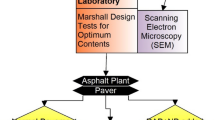Abstract
Within the framework of a sustainable development, manufacturing bituminous mixtures while reducing energy and using less new aggregates and new bitumen may be considered as an important topic, according to the quantities of asphalts mixtures produced for creating and maintaining road networks. This work aims to study the interest and the potential problems when coupling the warm mix asphalt technology (WMA) and the use of high ratio of reclaimed asphalt pavement (RAP) in the mixture. Initially, a study on managing RAP is performed, aiming to show that separating RAP aggregates in several fractions leads to a higher control of RAP in terms of homogeneity. Homogeneity of RAP is a key point for increasing recycling rates. The present study coupling WMA and RAP is based on the French design method for manufacturing asphalt concretes, which includes gyratory compaction tests, French wheel tracking tests, complex modulus tests and fatigue tests. However, the French design method does not take into account the physical and chemical aging of bituminous mixtures with time. As we consider that coupling WMA and RAP may lead to aging problems, it was decided to use an aging process before performing the standard tests. The results show that a WMA containing a high ratio of RAP has good performances according to the standard relative to this material, whatever the test. However, this material tends to be more sensitive to fatigue than hot and warm mixes without RAP.









Similar content being viewed by others
References
Anderson E, Daniel JS (2013) Long-term performance of pavement with high recycled asphalt content: case studies. Transportation Research Record: Journal of the Transportation Research Board, No. 2371. Transportation Research Board of the National Academies, Washington, DC, pp 1–12. doi:10.3141/2371-01
Apeagyei A, Clark T, Rorrer T (2013) Stiffness of high-RAP asphalt mixtures: Virginia’s experience. J Mater Civ Eng 25(6):747–754. doi:10.1061/(ASCE)MT.1943-5533.0000543
Bodin D, Terrier J-P, Perroteau C, Hornych P, Marsac P (2010) Effect of temperature on fatigue performances of asphalt mixes. In: 11th International conference on asphalt pavements, volume 1 of 3. ISAP, Nagoya. ISBN 978-1-61839-073-8
Colbert B, You Z (2012) The determination of mechanical performance of laboratory produced hot mix asphalt mixtures using controlled RAP and virgin aggregate size fractions. Constr Build Mater 26(1):655–662. doi:10.1016/j.conbuildmat.2011.06.068
Copeland A (2011) Reclaimed asphalt pavement in asphalt mixtures: state of the practice. Federal Highway Administration, Report No. FHWA-HRT-11-021. Form DOT F 1700.7 (8-72)
De la Roche C, Gabet T, Van de Ven M, Van den Bergh W, Grenfell J (2010) Results of interlaboratory tests on a laboratory bituminous mixtures ageing protocol. In: Proceedings of the 11th international conference on asphalt pavements, France
De la Roche C, Van de Ven M, Planche J-P, Van den Bergh W (2013) Hot recycling of bituminous mixtures. Advances in interlaboratory testing and evaluation of bituminous materials. State-of-the-art report of the RILEM Technical Committee 206-ATB, vol IX, pp 361–428, online. ISBN 978-94-007-5104-0. doi:10.1007/978-94-007-5104-0_7
EAPIC (2011) Essais d’Aptitude par Inter-Comparaison. Rapport de présentation des résultats N° 1-4-010. 1ème Campagne – 4ere Session – Série n° 10. http://www.idrrim.com/ressources/documents/1/858,EAPIC_Rapport-final-de-presentation-.pdf. Accessed 9 Oct 2014
IFSTTAR (2013) Un grand équipement de l’IFSTTAR: Le manège de fatigue des structures routières. Institut Français des Sciences et Technologies des Transports, de l’Amenagement et des Reseaux. http://35ans-manege.ifsttar.fr/docs/Plaquette-manegeV1.pdf. Accessed 7 Oct 2014
Molenaar A, Hagos E, Van de Ven M (2010) Effects of aging on the mechanical characteristics of bituminous binders in PAC. J Mater Civ Eng 22(8, SPECIAL ISSUE: Asphalt and Modified Asphalt Materials):779–787. ©ASCE, ISSN (online) 1943-5533. doi:10.1061/_ASCE_MT.1943-5533.0000021
Moutier F (1991) Etude statistique de l’effet de la composition des enrobés bitumineux sur leur comportement en fatigue et leur module complexe. Bull Liaison Lab Ponts Chaussées, Numéro 172:71–79
Oliveira JRM, Silva HMRD, Abreu LPF, Gonzalez-Leonc JA (2012) The role of a surfactant based additive on the production of recycled warm mix asphalts—less is more. Constr Build Mater 35:693–700. doi:10.1016/j.conbuildmat.2012.04.141
Kalman B et al (2013) Re-Road—end of life strategies of asphalt pavements. Deliverable 7.3, Project Final Report. European Comission DG Reserach. A FP7 Collaborative Project. Grant SCP7-GA-2008-218747. http://re-road.fehrl.org/index.php?m=64. Accessed 20 oct 2014
CFTR-info Nº17 (2008) Enrobés Bitumineux á Chaud - Mise en Application des Nouvelles Normes NF EN. Comité Français pour les Techniques Routières. Référence du document: RI 0802. http://dtrf.setra.fr/pdf/pj/Dtrf/0005/Dtrf-0005497/DT5497.pdf. Accessed 20 Oct 2014
Tarbox S, Daniel JS (2012) Effects of long-term oven aging on reclaimed asphalt pavement mixture. Transportation Research Record: Journal of the Transportation Research Board, No. 2294. Transportation Research Board of the National Academies, Washington, DC, pp 1–15. doi:10.3141/2294-01
Valdés G, Pérez-Jiménez F, Miró R, Martínez A, Botella R (2011) Experimental study of recycled asphalt mixtures with high percentages of reclaimed asphalt pavement (RAP). Constr Build Mater 25(2011):1289–1297. doi:10.1016/j.conbuildmat.2010.09.016
Zhao S, Huang B, Shu X, Jia X, Woods M (2012) Laboratory performance evaluation of warm-mix asphalt containing high percentages of reclaimed asphalt pavement. Transportation Research Record: Journal of the Transportation Research Board, No. 2294. Transportation Research Board of the National Academies, Washington, DC, pp 98–105. doi:10.3141/2294-11
Acknowledgments
The authors would like to thank the financial support of Coordenação de Aperfeiçoamento de Pessoal de Nível Superior—CAPES (Sandwich Doctoral Program (PDSE/CAPES)) and Conselho Nacional de Desenvolvimento Científico e Tecnológico—CNPq (Science without Borders (SwB) program - Doctorate Sandwich Abroad (SWE)).
Author information
Authors and Affiliations
Corresponding author
Rights and permissions
About this article
Cite this article
Lopes, M., Gabet, T., Bernucci, L. et al. Durability of hot and warm asphalt mixtures containing high rates of reclaimed asphalt at laboratory scale. Mater Struct 48, 3937–3948 (2015). https://doi.org/10.1617/s11527-014-0454-9
Received:
Accepted:
Published:
Issue Date:
DOI: https://doi.org/10.1617/s11527-014-0454-9




